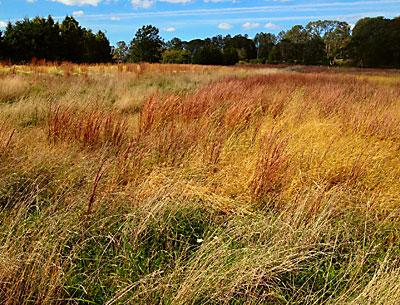Nature Notes: Art and Nature

It’s that time of year again. The winter birds are beginning to show up, the ospreys have left, and the cormorants are lingering on their way south because the fishing is so good. The last of the asters and goldenrods are peaking prior to their flowers turning into dandelion-like heads with tiny seeds on parachutes that can float for miles before settling down. Most of the trees are still green, but it’s only a matter of days before their leaves find other colors to sport, the air grows crisp, and suppers are eaten in the dark.
A lot of people go to New England to view the red, orange, and yellow foliages. I prefer to stay here and take my chances. In some years the fall colors here match those of the Appalachians, in most years not. This could be one of those years when they do.
The first to turn are the dogwoods, followed by the tupelos, which also become a burgundy red, followed closely by the orangey reds of the swamp maples. Each year, some of the prettiest of the latter two species can be seen along Swamp Road in East Hampton’s Northwest, while the dogwoods range throughout the whole of Northwest and parts of northern Amagansett. The stand of tupelos along Cranberry Hole Road at the intersection of Bendigo Road in Amagansett is also sure to please. Aptly named Euonymus purpurea, the euonymuses or burning bushes, native to the south but not to here, never fail to knock your eyes out from the sides of the roads as you drive past. The way global warming is progressing, soon we’ll be calling them natives.
Our most ubiquitous oak, the scarlet oak, has the most impressive fall foliage of the oaks. The yellows and reds of the sassafras can dazzle the eyes here and there, while hickories turn mostly yellow. While traveling Old Northwest Road, Northwest Road, Bull Path, Two Holes of Water Road, Alewife Brook Road, and Springy Banks Road, don’t look down — the understory huckleberry-blueberry layer lost its luster and most of its leaves weeks ago — but look up at the oaks, hickories, and sassafras.
The Stony Hill woods of Amagansett are the most diverse and richest in terms of tree species on the South Fork. You will find all of the above named trees there, in addition to American beech, which turns yellow, and sweet birch, which turns yellow and red.
But it’s not just the trees and the wildflowers that make for a pleasant country drive, bike ride, or walk along South Fork roads in October. The hues of the grasses, if more subtle, can be just as spirit-lifting. Fall grasses are not green like summer and spring grasses. Little bluestem, which may be our most common native grass, is a combination of yellows, blues, reds, and purples, most of which remain that way through the rest of fall and much of winter. Another grass, purple love grass, is my favorite and in this century has become almost as common as the former. Fields and road shoulders, such as the median of the Sunrise Highway, have monoclonal stands of it — a low red-purple haze delights the eye of the passerby.
Salt marsh edges are very colorful at this time, as well. Spartina grasses, cordgrass, and salt marsh hay become tawny, the reds of the salicornia, or pickleweed, give the marsh a patchwork appearance. The voluminous clusters of bright whites of the groundsel bush, or sea myrtle, flowers fill out this crazy quilt of colors. The edges of Accabonac Harbor in Springs and Scallop Pond in North Sea are two of the best sites for salt marsh colors each fall. It is not by coincidence that some of Jackson Pollock’s canvases are crazy-quilted tapestry in the same way — the Pollock-Krasner House on Fireplace Road has one of the most exquisite salt marsh panoramas on Long Island.
Be green, save on gasoline, poke around here on the South Fork to feast your eyes on nature’s autumn splendor. When you do, ask yourself, why are there so many different colors and patterns and why are they either vivid or subdued, but all the while so pleasing to the senses? Fall colors have little function with respect to the plants responsible for them, while the colors of spring and summer are those underlying vital plant processes — flowering, fruiting, and photosynthesis. Except for the primates, other mammals don’t perceive them, while birds do. It is the very foundation of aesthetics based on color.
What is the value of art other than the fact that it pleases us such that magnificent edifices are designed to exhibit it the world over? It doesn’t become more aesthetic with age, but only much more valuable economically. It is what it is. Irrespective of politics, the antithesis of aesthetics, art and nature are there for all of us. Our five senses are required for survival, but art and nature make survival worthwhile and pleasurable. Don’t you agree?
